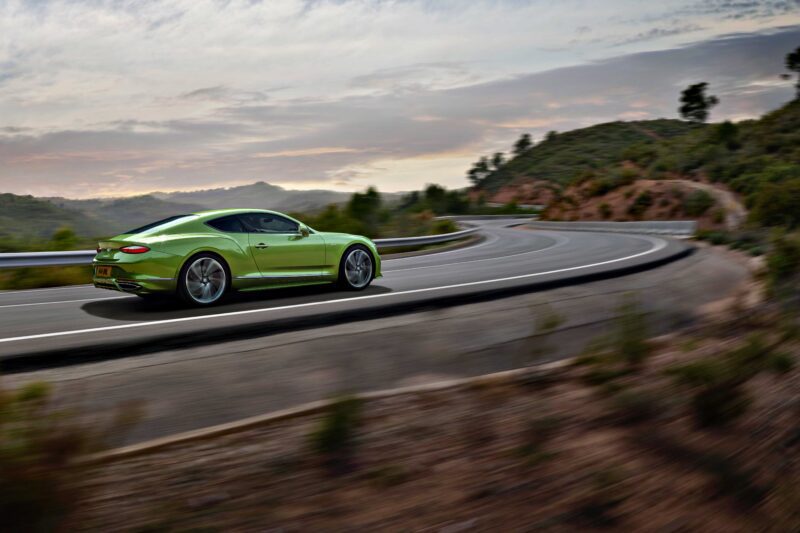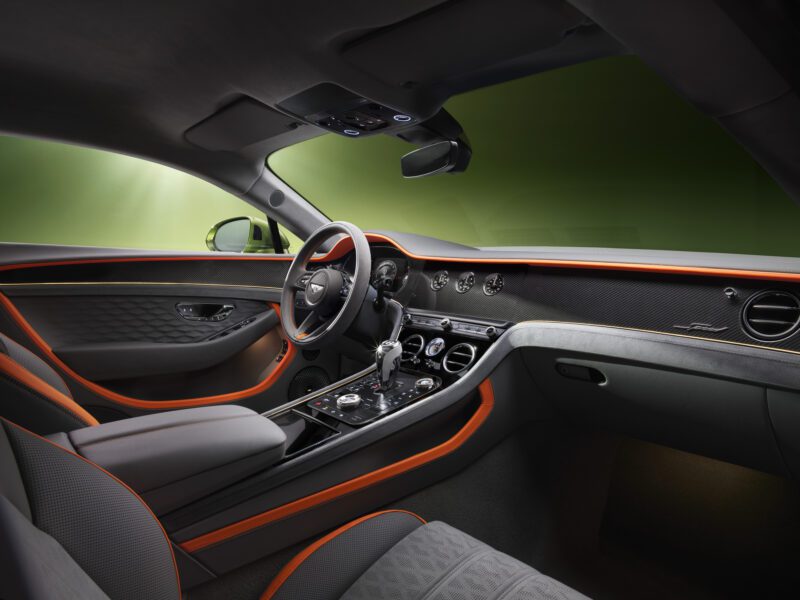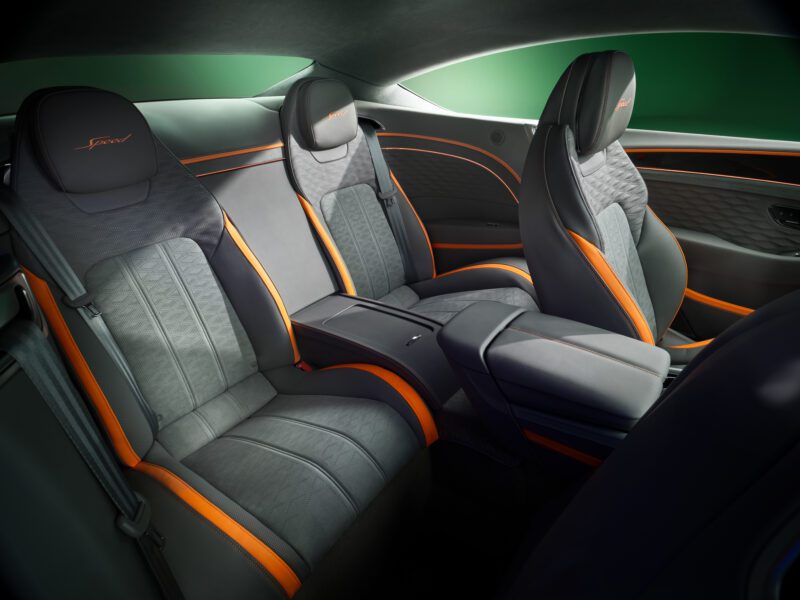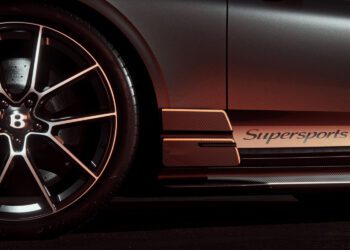Thirty-five miles into an efficiency run in the 2026 Bentley Continental GT Speed, I’m getting itchy for the plug-in hybrid battery to run out of juice. Twisty roads are coming up, and I’m eager to unleash this beautiful British beast’s sound and fury.
During my electric run, the car effectively has 188 horsepower and 332 pound-feet of torque from a motor located within the eight-speed dual-clutch automatic transmission. It’ll run almost silently on electricity alone as long as I don’t go deeper than 75 percent of the way into the throttle pedal travel or hit 87 mph. I manage not to trigger either eventuality and find the motor has enough thrust to keep up with traffic and ramp up to freeway speeds. The sound-free driving seems appropriate in this ultra-luxury grand tourer, but I know there’s another, more sinister side to this plug-in hybrid.
After 38 miles of driving only on electricity, the electric power finally runs out. That’s 10 miles less than the instrument cluster indicated before my run, but eight miles more than the EPA-rated 30 miles of range from the 25.9-kWh battery (80 percent of that is usable, according to Bentley).

Now the fun begins. The twin-turbocharged 4.0-liter V8 fires up with a deep and determined growl as the powertrain switches from EV mode to Hybrid mode. The motor is still available to aid the engine and provide torque to fill off the line and during shifts of the smooth and quick-acting transmission. But I go a step further and switch from the base Bentley drive mode to Sport mode, which not only uses the electric motor but also overruns the engine to charge the battery. Over 55 miles in Sport mode, it adds 14 miles of charge.
With the engine in the mix, the Continental GT Speed puts out numbers that easily eclipse the 650 horsepower and 664 pound-feet of torque of the outgoing generation’s W12 powertrain. Total output is 771 horsepower and 738 pound-feet of torque, making this the most powerful Bentley ever.
The power is generally well controlled and only hits hard when I do the same to the throttle pedal. From a stop, it can rocket the Continental GT Speed to 60 mph in a scant 3.1 seconds, about the same as the last model due to the weight added by the hybrid system. If I had the room and the will, it could keep going all the way to 208 mph. I lack both, but the power goes to the pavement efficiently thanks to the standard all-wheel-drive system, and it builds relentlessly. On gas, the EPA rates the GT Speed at 19 mpg combined, and that seems to be confirmed by the 21.5 mpg I average over 165 miles of driving with about 60 miles of electric driving.

The plug-in hybrid powertrain certainly makes the GT Speed quick, but it also adds some unwelcome weight. This car weighs in at a portly 5,421 pounds, about 370 pounds more than the last-generation model with its heavy W12. That means the Continental GT Speed leans toward grand tourer rather than sports car more than ever. However, Bentley does everything it can to wrangle the weight and provide engaging handling. The suspension starts with aluminum double wishbones up front and an aluminum multi-link design in the rear. It builds on that with adaptive dampers and four-corner air springs. It also has active anti-roll bars, rear-axle steering, and an electric limited-slip differential.
All that technology does its job quite well. The Continental GT Speed feels wide and planted on the road, with sharp, weighty steering that exudes stability. The active anti-roll bars create a rather flat cornering attitude, the 275/35R22 front and 305/30R22 rear Pirelli P Zero tires grip hard, and the car rotates willingly without the push I’d expect given the weight. That’s likely due to the near-perfect 49/51 front-to-rear weight balance achieved by mounting the battery in the trunk area, where it saps some of the cargo space. The e-diff, rear torque vectoring, and all-wheel-drive system put the power down efficiently mid-corner and upon corner exit, while the rear-axle steering contributes to the stability in high-speed corners and shortens the turning radius by turning up to 4.1 degrees opposite the fronts.
When it comes time to arrest the GT Speed’s speed, Bentley has me covered, too, with a massive set of 16.9-inch ventilated front rotors clamped by 10-piston calipers and 15-inch rear rotors with six-piston calipers. That’s a lot of swept braking surface, but if you’re going to test out those 200-mph speeds, maybe you should spend another $18,820 for the carbon-ceramic brakes on my test vehicle that up the rotor sizes to 17.3 inches in front and 16.1 inches in the rear.



The power and handling are treats, but so is the cabin. Bentley is a purveyor of some of the finest interiors on the market, and the Continental GT Speed doesn’t disappoint. It comes standard with 20-way power-adjustable front seats with quilted leather upholstery, heating, ventilation, and massage, and it sports beautiful materials lovingly hand assembled. Tech features include a digital instrument cluster and a 12.3-inch infotainment touchscreen.
My tester also has a bumpin’ 2,200-watt Naim audio system with 18 speakers as part of the $50,940 First Edition specification that also includes the cool three-sided rotating center screen, front seats that automatically adjust their posture and climate settings, a host of lighting elements, and several “First Edition” insignia. The rear seat, however, remains a penalty box fit for two kids or a pair of sadomasochistic adults.
The Continental GT Speed starts at $306,250, including a hefty $4,150 destination charge. However, my test car has $86,000 in options to bring the total to $392,735. Aside from the brakes, most of the options are for cosmetic features, including the First Edition spec, some black exterior trim, and a Mulliner color option. Once the price for a car reaches average home territory, option prices don’t matter as much as the heart’s desires.
The change from a W12 to a plug-in hybrid V8 powertrain makes the 2025 Bentley Continental GT Speed more efficient and unlocks a quiet side, but should you get behind the wheel, be sure to experience its extroverted, sinister side as well.

Images: Bentley











